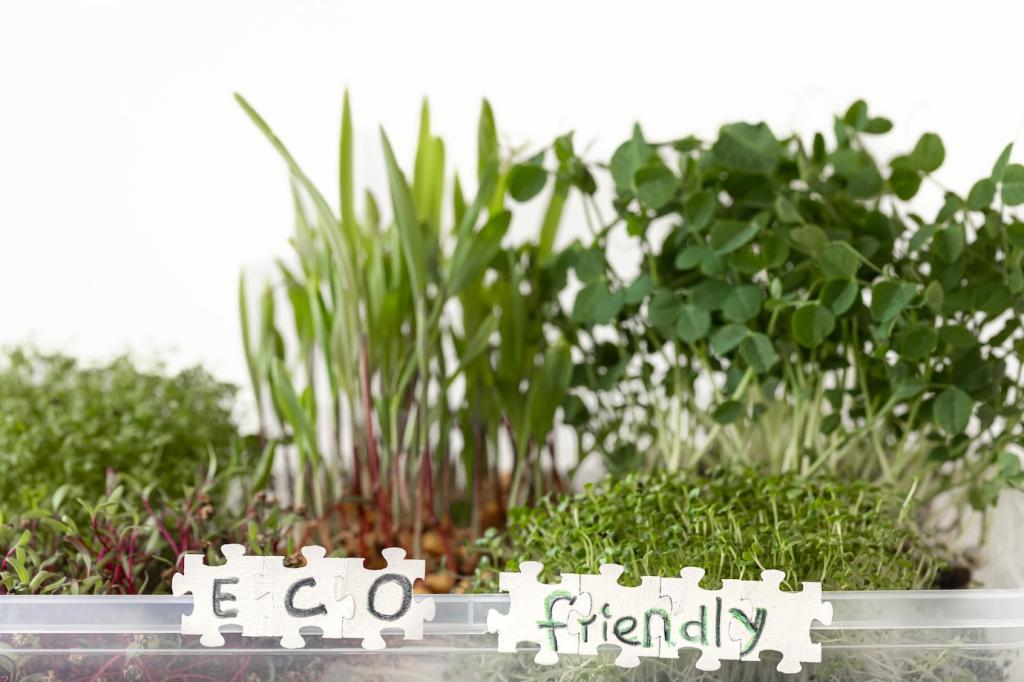
Low-Impact Tiny Home Landscaping Ideas
Chosen theme: Low-Impact Tiny Home Landscaping Ideas. Welcome to a gentler way to green your small space—designs that sip water, tread lightly on soil, and bloom with purpose. Explore clever, beautiful solutions, then share your wins, ask questions, and subscribe for fresh tiny-yard inspiration.
Arrange leftover bricks, broken tile, or salvaged pavers into irregular stepping islands with generous joints. Fill gaps with grit or creeping thyme so rain soaks in, not out. Post a picture of your mosaic and note how your soil responds after the first big storm.

Native, Drought-Smart Planting for Tiny Spaces
Pocket Prairie in a Planter
Create a mini meadow using native bunchgrasses and compact wildflowers in a deep container. Stagger bloom times for a long nectar season. Keep soil lean and mulch lightly. Share your species list and bloom calendar to help neighbors recreate that buzzing, low-water magic.


Shrub Anchors That Stay Polite
Choose modest native shrubs that top out around chest height—think manzanita dwarfs, inkberry compacts, or low blueberry. They frame views, break wind, and feed birds without crowding walkways. Tell us which varieties stay tidy in your region and how you prune for airflow.

Vertical Green: Trellises, Ladders, and Light
Stainless cables span between slim posts, guiding vines while a rain chain draws water into a barrel below. In sun, try passionflower or beans; in shade, go for star jasmine. Share your vine choices and how quickly you achieved full coverage through the seasons.
Vertical Green: Trellises, Ladders, and Light
Disassemble heat-stamped pallets to build pocket planters lined with breathable fabric. Plant strawberries, herbs, and trailing natives to soften the wall. Keep irrigation low with drip lines tucked behind. Tell us where you safely sourced pallets and what soil mix kept roots happiest.
Water Wisdom: Rain, Greywater, and Slow Release
Mount a food-grade barrel on a sturdy stand, filter with a mesh screen, and run a low-flow drip line to planters. Gravity handles the rest. Log your weekly usage and plant response, then tell readers how much municipal water you saved across one season.
Water Wisdom: Rain, Greywater, and Slow Release
Bury unglazed clay ollas between plants and fill occasionally; water seeps through the pot walls directly to roots. Top with wood chips to curb evaporation. Share your refill interval and which crops or natives responded best to this quiet, efficient underground irrigation method.
Water Wisdom: Rain, Greywater, and Slow Release
Sculpt a shallow swale where roof runoff lands, then plant deep-rooted natives that tolerate wet-to-dry swings. Add river stones to slow flow. After a storm, snap a photo of infiltration within 24 hours and report your soil type so others can match your results.
Bee Hotel from Pruned Stems
Bundle hollow stems from winter pruning in a weather-sheltered frame, leaving varied diameters for solitary bees. Face east for morning warmth. Monitor occupancy, and comment on which materials lasted longest so others can improve their low-impact pollinator housing next season.
Shallow Saucer Birdbath in Dappled Shade
Set a low dish on a stone, add a pebble ramp for insects, and refresh daily with collected rainwater. Keep it near shrubs for safe perches. Share which birds visit and how you deter mosquitoes naturally without chemicals, keeping the whole setup gentle and clean.
Night Pollinators and Softer Light
Moths and bats need darkness. Swap harsh bulbs for warm, shielded, low-lumen fixtures on timers. Add pale, night-blooming flowers to guide them. Track night visitors with a notebook or camera, then tell us what bloomed and who arrived, inspiring others to dim and delight.
Soil First: Quiet Care and Compost That Disappears
Vermicompost in a Discreet Tote
A lidded bin with air holes, bedding, and red wigglers turns scraps into black gold. No odors when balanced right. Harvest castings quarterly and side-dress containers. Share your favorite feedstock, and how much kitchen waste you’ve diverted since starting your tiny worm farm.
Leaf Mold Magic in a Simple Crate
Cage autumn leaves in a breathable crate and forget them for a year. Fungi transform fluff into sponge-like mulch. Spread around natives to conserve moisture. Tell us how leaf mold changed your watering schedule and if your paths felt cooler through peak summer heat.
Wood Chips as Fungal Highways
A few inches of arborist chips nurture mycorrhizae, stabilize moisture, and soften footsteps. Keep chips off trunks, refresh lightly each year, and observe soil life. Report back when mushrooms appear and whether your plants needed less water after the fungal network established.
